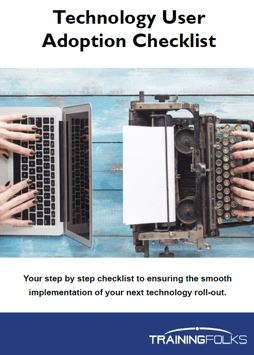How to Increase User Adoption of New Technology

Those of us who have worked through botched technology roll-outs know that those shiny, exciting tech additions will quickly turn disastrous if the new users have little interest in it, and struggle to adopt the technology. It's important to understand that implementing new technology that ensures high user adoption will be different for all organizations, industries and departments.
Think of an employee, that doesn't enjoy working with a newly implemented CRM. Their constant negativity about it has begun to poison the people around them, that might have otherwise openly adopted the new system.
Situations like this could lead to the derailment of your new technology project, even though the tool was the perfect solution, delivered at the right time and designed to improve efficiency.
New technology user adoption hinges on your ability to plan for, and fully execute, a successful change initiative. Try using the following user adoption strategies to help make your next new technology launch successful.
Choose New Tools With Care
Making sure employees adopt new tech begins with a couple of things:
1. The power and performance of the new technology
2. Solid new technology user adoption training
First, we'll tackle how to choose the best tools to promote employee adoption. To begin, try asking yourself the below questions when you first consider the addition of any new technology:
1. What benefits will the tool bring into my organization?
You probably wouldn't consider implementing a new tool if it didn't bring something new to the table. When you are early on in the process, take some time to quantify the benefits.
As with other areas of your business, create a full business case for the addition of the tool. By doing this, you'll start building your "sales pitch" that will be needed down the road when it's time to get the team on board. List the benefits such as time/cost savings, increased efficiencies or improved functionality.
2. Does the tool resolve any key employee pain points? Which ones and how?
Is this new tool going to make your employee's lives better? Determining the answer to this question will be an integral component in how successfully you'll get them onboard.
Spend some time to speak with several key people, and try to get a better understanding of the ways your new tool can help them.
3. Do the employees have more pressing pain points that are a higher priority?
Even if the tool you want to adopt will resolve a given set of pain points that you've already identified, consider if there other pain points that your employees would rank higher. If those pain points are left unresolved, the onboarding efforts for your new proposal may stall.
4. What are the resources that you'll need to successfully roll out the new project?
Will a lot of productivity be lost during the changeover to the new tool? Will user adoption training or additional support resources be required?
To make sure all of the trade-offs add up, consider what you'll need to invest in light of the benefits you expect from a successful implementation.
Identify the Stakeholders Involved
These recommendations may sound obvious on the surface, but what we see too often are organizations that only look at their key stakeholders at a high level. By doing this, the full impact on all users often gets missed, leading to employees feeling left in the dark and resentful of a technology they know little about.
For example, let's look at a decision to implement a new accounting system to more efficiently handle your accounts payable and receivable.
In this situation, your accountants and book keepers would represent the key stakeholders you'd want to consider before deciding on the new tech. These employees should be key to the development of your employee user adoption plan.
But how about your HR reps that also handle your payroll functions? Did you consider your specialists in supply chain management that routinely consult your accounting system to track which shipments have been placed and paid for?
In order to gain a thorough understanding of everyone that will need to get involved in the adoption plan, you're going to have to talk to a lot of people. Why not use a power-interest stakeholder matrix in order to map out everyone that will have a stake in the project.
Build Your Plan for Roll-Out
After you've made your decision about the new tech, it's time to use all of the information you gathered about pain points, benefits and stakeholders to start creating your plan for a roll-out.
The size and overall scope of the roll-out plan will vary depending on what type of tech you've chosen, but may involve all of any of these elements:
1. Target Dates
When exactly will the new technology be ready for roll-out? When will users be required to switch to the new technology? At what point will the current tool be turned off? Users should be aware of the timelines involved.
2. Tiers of Deployment
Will the new tool be rolled out to all users at the same time? Would it be a better decision to onboard individual groups so that each receives new technology user adoption training? Why not select a group of ‘Super Users’ who will be experts in the software that can be involved in the project. They can also act as post training support.
3. Opportunities for Training
What kind of user adoption training will be needed? Will some employee groups or departments need more training on the new system than others? How do you intend on accounting for varied styles of learning?
4. Set Clear Expectations
Do you plan on recognizing users that make a strong effort at learning the new tool? Will there be punishments for employees that refuse to use it? During the new technology user adoption phase, remember to consider the standard cycle for adoption. Not all employees will transition at the same pace. Expect laggards and early adopters.
Keep in mind how diverse your workforce is and set realistic expectations accordingly.
Training Can Be Fun
Take a minute and think back personally to when you got a new piece of technology that genuinely excited you. Perhaps it was a television, computer, tablet or the latest iPhone.
Was learning how to use it a burden, or did you enjoy it? The odds are that you were genuinely excited to start figuring out how the new device worked.
While it might be difficult to get employees this excited about your new intranet, or accounting software, that is the type of feeling you should try to inspire.
There are many ways you can accomplish this:
1. Use formats that are Fun
Rather than hosting a Zoom presentation, why not try using eLearning that incorporates interactive features, quizzes or video to engage your learners. You could host (and pay for) a ‘lunch and learn’, even if your employees are working remotely. Consider Virtual Instructor Led Training (vILT) to make the learning more collaborative.
Consider creating a scavenger hunt into the new technology to get your employees excited about exploring it and offer prizes.
2. Give Incentives
Show your workers that you genuinely value when they take learning efforts seriously on the new tool. Offer rewards like swag, coffee gift cards or other small perks.
When entire departments hit their milestones for adoption, take time to recognize these efforts with an award or memo that goes out to the entire company.
3. Choose the Right Trainers
User adoption training may be part of the install package of your new technology tool. If not, it's important to hire the best solution for the ultimate success at implementation.
It's wise to take full advantage of the wisdom of the presenters when you have them. But if you're working with a trainer that doesn't inspire your workers to use the new tech to its full capabilities, consider looking for a new trainer.
You Can Increase User Adoption
Employee adoption often lags when it's time to introduce new technology into their lives.
By implementing these strategies, you'll be well on your way to a successful tech adoption.
Get more information on how to Increase User Adoption of new Technology with our FREE download 'Technology User Adoption Checklist'


